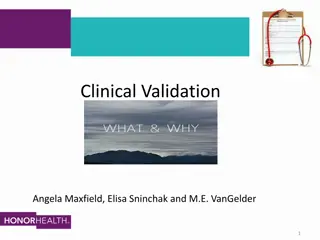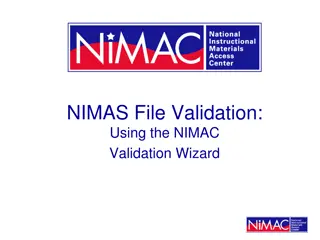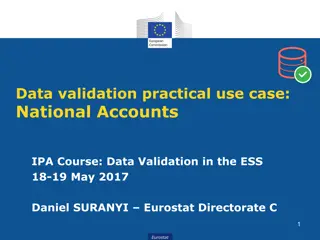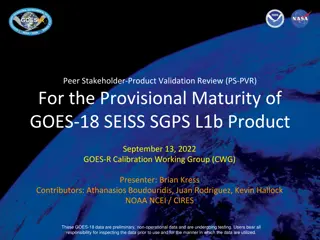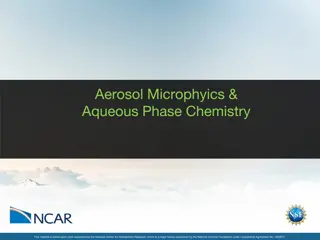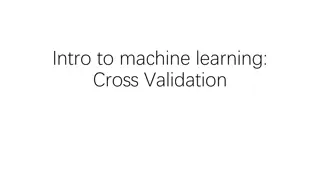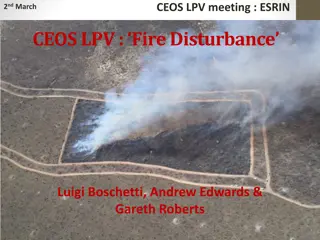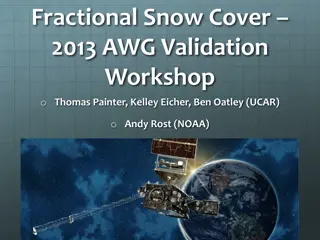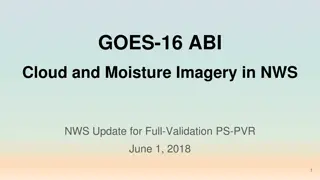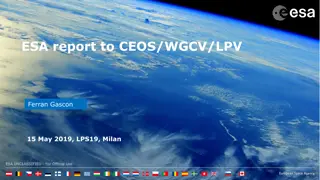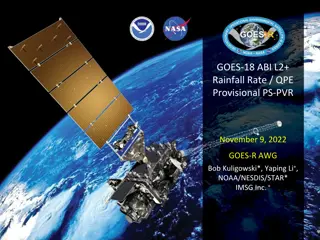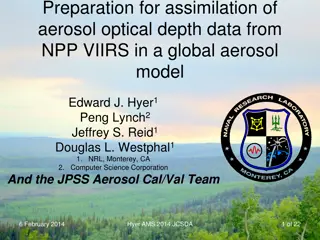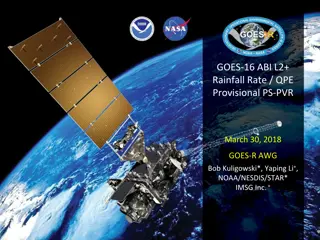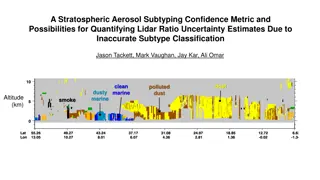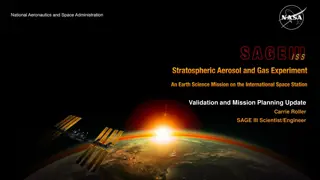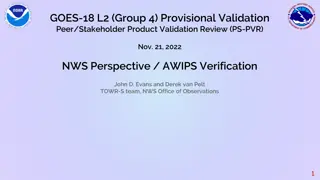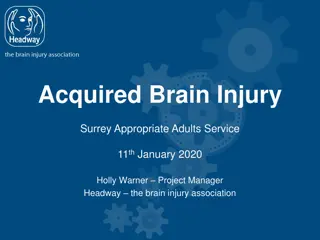GOES-R ABI Aerosol Detection Product Validation Summary
The GOES-R ABI Aerosol Detection Product (ADP) Validation was conducted by Shobha Kondragunta and Pubu Ciren at the NOAA/NESDIS/STAR workshop in January 2014. The validation process involved testing and validating the ADP product using proxy data at various resolutions for detecting smoke, dust, and aerosols. Ongoing efforts included generating ADP Level-2 proxy products, testing algorithms, and assessing dust masks and smoke detection using satellite data and models. The future generation of ADP products for GOES Imager ABI Band included details on wavelengths, central wavenumbers, and sample uses. The product assessment also outlined the number of events, sources of proxy inputs, and coverage periods for dust and smoke detection. Matchup criteria involved temporal and spatial considerations for categorizing dust and non-dust aerosols based on specific criteria.
Download Presentation

Please find below an Image/Link to download the presentation.
The content on the website is provided AS IS for your information and personal use only. It may not be sold, licensed, or shared on other websites without obtaining consent from the author. Download presentation by click this link. If you encounter any issues during the download, it is possible that the publisher has removed the file from their server.
E N D
Presentation Transcript
GOES-R ABI Aerosol Detection Product (ADP) Validation Shobha Kondragunta1 and Pubu Ciren2 1NOAA/NESDIS/STAR 2IMSG@NOAA Second AWG Validation Workshop January 9-10, 2014
Product Generation and Assessment (1) 2 Aerosol Detection Product Smoke and dust at 2 km resolution Testing of the product and validation using proxy data is, however, done at pixel resolution 1 km for MODIS 750 m for VIIRS Smoke from fires in California on October 28, 2003 Saharan dust storm off of Africa on September 4, 2005
Product Generation and Assessment (2) 3 Ongoing generation of ADP Level-2 proxy product with MODIS L1B as proxy. Ongoing testing of ADP algorithm using VIIRS L1B as proxy. Ongoing assessment of ADP dust mask with CALIPSO VFM and AERONET, and smoke detection with CALIPSO VFM and AIRS Carbon Monoxide (CO).
Product Generation and Assessment (3) Future GOES Imager (ABI) Band Nominal Wavelength Range ( m) Nominal Central Wavenumber (cm-1) Nominal sub- satelliteIGFOV (km) Nominal Central Wavelength ( m) Sample Use M3 M7 M9 M10 M11 M12 1 0.45-0.49 0.47 21277 1 Dust/Smoke 2 0.59-0.69 0.64 15625 0.5 Dust/Smoke 3 0.846-0.885 0.865 11561 1 Dust/Smoke 4 1.371-1.386 1.378 7257 2 Dust/Smoke 5 1.58-1.64 1.61 6211 1 Smoke 6 2.225 - 2.275 2.25 4444 2 Smoke 7 3.80-4.00 3.90 2564 2 Dust/Smoke 8 5.77-6.6 6.19 1616 2 9 6.75-7.15 6.95 1439 2 10 7.24-7.44 7.34 1362 2 11 8.3-8.7 8.5 1176 2 M15 M16 12 9.42-9.8 9.61 1041 2 13 10.1-10.6 10.35 966 2 14 10.8-11.6 11.2 893 2 Dust/Smoke 15 11.8-12.8 12.3 813 2 Dust/Smoke 16 13.0-13.6 13.3 752 2 VIIRS bands mapped to ABI
Product Generation and Assessment (4) 5 No. of events (Granules) Source of Proxy input Time period coverage Geo- coverage Dust Smoke MODIS L1B radiance March 2000 - present 526 263 Global VIIRS L1B radiance June 2012 present 43 23 Global Simulated Radiance with WRF-CHEM (from CIMSS) 2010.08.24-2010.08.25 0 1 CONUS
Product Generation and Assessment (5) 6 Matchup criteria Temporally: 15 minutes from MODIS overpass time Spatially: a circle with a 25 km radius centered around AERONET station Dust and non-dust categories AERONET Dust: AOD > 0.3 and Angstrom Exponent < 0.6 Non-dust: Angstrom Exponent > 0.6 ADP Dust: Ratio of dust/non-dust pixels in the matchup region > 66% Non-dust: ratio of dust/non-dust pixels in the matchup region < 33%
Product Generation and Assessment (6) 7 AIRS Total column carbon monoxide (CO) is introduced as a validation dataset for smoke mask from ABI ADP Advantages: On the same platform as Aqua MODIS High values of CO are present in smoke plumes from fires Disadvantages: Low spatial resolution ( ~14 km ) Retrieval sensitivity higher for elevated (mid troposphere) CO
RGB image Product Generation and Assessment (7) 8 Smoke from multiple fires in the western US on 09/15/2012 captured by both Aqua MODIS and SNPP VIIRS. ADP ADP UTC:2110 UTC:1935 SNPP VIIRS granules Aqua MODIS granules
RGB image Product Generation and Assessment (8) 9 Dust off of Africa on September 14, 2013 nicely captured when ABI algorithm was applied to VIIRS but not MODIS. Sunglint an issue for MODIS. UTC:1455 SNPP VIIRS granules Aqua MODIS granule
Product Generation and Assessment (9) 10 Time Series of Dust Detection Matchups with AERONET POD=88% FAR=38% 2006
Aqua MODIS RGB Product Generation and Assessment (10) 11 AIRS total column CO is being used to evaluate smoke detection from ABI ADP. ABI algorithm was tested on smoke from fires in Greece on August 25, 2007 observed by Aqua MODIS. Parts of the smoke plume well detected by ABI algorithm but a big blob of smoke plume was not detected. AIRS Total column CO ABI ADP No smoke in ABI ADP corresponding to this CO plume. This is also the sun glint region.
MODIS RGB Product Generation and Assessment (11) 12 A few days later on August 28, 2007 AIRS doesn t have coverage (due to orbital gap) for the region that MODIS shows a very large area of smoke. AIRS Total column CO ABI ADP
Product Generation and Assessment (12) 13 User engagement (more focus on SM/AOD than aerosol detection) NWS Need: Operational air quality forecast verification Engagement: through GOES-R air quality proving ground activities the last 4 years. Annual workshops with hands on exercises and demos PG telecons Others (EPA, state/local agencies, ) Need: air quality monitoring and exceptional events rule Engagement: through GOES-R air quality proving ground activities the last 4 years Annual workshops with hands on exercises and demos Presentations at meetings such as AMS, AGU, etc. Youtube videos (http://youtu.be/vuoDpVafZAA and http://youtu.be/k17IYMCcHvY) released (beta version) and played at NOAA booth during AGU and AMS.
Routine Validation Tools against CALIPSO VFM 14 Routine processing of ABI ADP algorithm on MODIS L1B data and near real time evaluation using CALIPSO data http://www.star.nesdis.noaa.gov/smcd/spb/pubu/validation_new_test/adp_abi_calipso.php Match-ups and Statistics metrics are automatically generated and produced for each smoke/dust event.
Results from Routine Validation Tools against CALIPSO VFM: Dust 15 Performance metrics for Aqua MODIS dust mask from Dust Aerosol Index algorithm and ABI aerosol detection algorithm against CALIPSO Vertical Feature mask (VFM) product. Time period: from 2006 to 2012 with total 18358 matchups (15477 and 2881, respectively for over land and water). Surface Type Accuracy (%) POCD (%) POFD (%) VIIRS DAI algorithm on MODIS 70.0 80.6 49.7 Land ABI ADP algorithm on MODIS 63.6 44.1 74.2 VIIRS DAI algorithm on MODIS 82.3 76.1 18.9 Water ABI ADP algorithm on MODIS 66.1 59.5 25.4 Specification for ABI dust detection is 80% over land and water POCD: Probability of Correct Detection POFD: Probability of False Detection
Results from Routine Validation Tools against CALIPSO VFM: Smoke 16 Performance metrics for Aqua and Terra MODIS smoke detection using ABI ADP algorithm. Surface Type Accuracy (%) POCD (%) POFD (%) Land 69.1 66.7 28.6 73.6 63.4 31.6 Water Specification for ABI smoke detection is 80% over land and 70% over water POCD: Probability of Correct Detection POFD: Probability of False Detection
A case study of mixed dust and smoke on July 28, 2007 17 ABI ADP on MODIS
Algorithm Enhancements 18 Internal cloud tests to improve cloud/dust discrimination. Bright pixel index to reduce false dust detections. NDVI and view angle dependent thresholds Aggregate the pixel level retrieval to a 2-km product
Post-Launch Test (PLT) and Post-Launch Product Validation 19 Work with calibration team to determine that all ABI bands are fully functional. Tune thresholds with collocated CALIPSO VFM. Generate global monthly mean smoke/dust fraction and compare to both CALIPSO and MISR to evaluate ABI ADP spatial and temporal patterns. Compare ABI ADP to SNPP VIIRS dust and smoke. Focus on Alaska in the evaluation because of availability of multiple views from VIIRS.
ABI Retrieval Bias RMS Aerosol height (h) from 6S 13.53 14.50 Aerosol height (h) from aircraft -4.30 6.20 h ABI vs. AIRNOW July 2011 mass concentration (PM2.5) comparisons during DISCOVER-AQ GOES-R ABI estimates of surface PM2.5 correlate well with AIRNOW (ground) but there is a bias of 13.53 g/m3 (data in red) In scaling ABI AOD to PM2.5, a 3 km aerosol height was assumed as in 6S radiative transfer model. Aircraft data show aerosol height of 1.1 km.. Therefore, ABI estimates of surface PM2.5 were adjusted accordingly. Analysis indicates that knowing aerosol height is very important when AOD is scaled to surface PM2.5 concentrations. Chuanyu Xu of IMSG contributed to the aircraft data analysis
Summary 21 Processing ABI ADP algorithm over a long time period revealed some algorithm issues: False dust detections over bright surfaces which will be avoided with the introduction of bright pixel index based on NDVI to screen out the bright pixels; Most matchups of CALIPSO were also for thin dust plumes for which ABI is not expected to perform well (only plumes with AOD > 0.2 are expected to be detected); Performance metrics for smoke are closer to specifications but metrics depend on matchup data. Sample size is not large enough due to narrow CALIPSO scan; Additional validation datasets (AIRS CO and VIIRS ASDA product) will be considered in the future for evaluation of ABI smoke detection. Comparison of ABI ADP with VIIRS dust detection has shown that the lack of 412 nm on ABI is going to be a short coming. Evaluation of ABI suspended matter (PM2.5 concentration) Field campaign data from DISCOVER-AQ (B-W area, Califorina San Joaquin valley, Houston) will be acquired to generate validation statistics stratified by geographic region and aerosol type.


